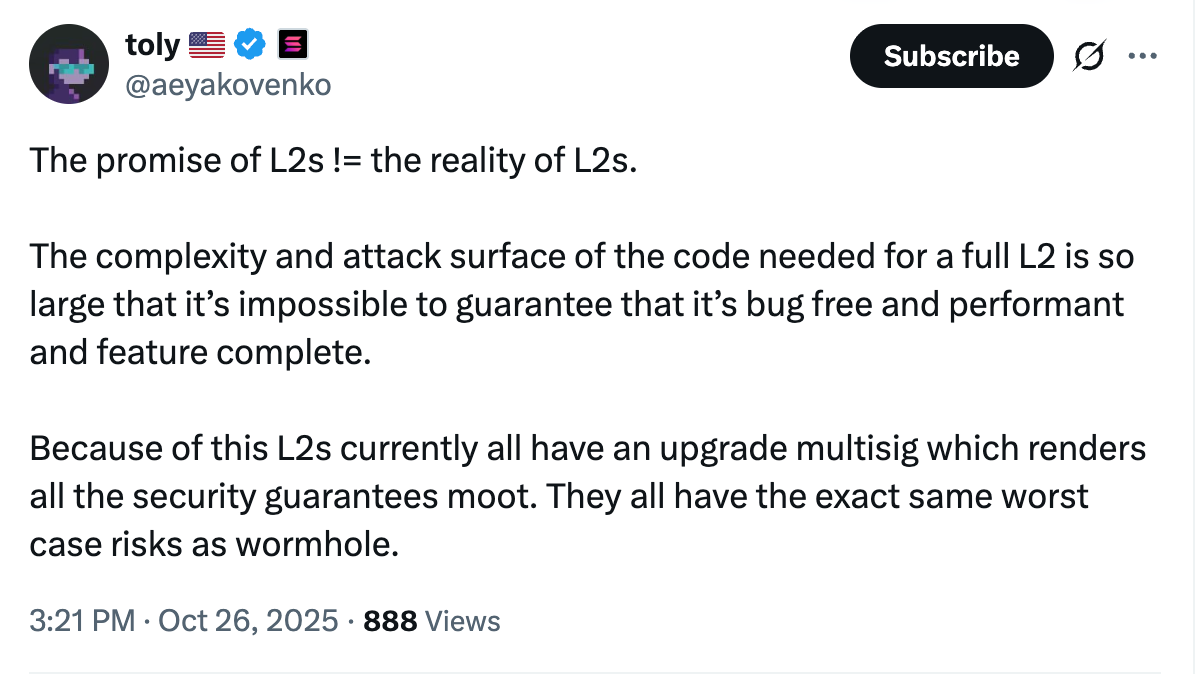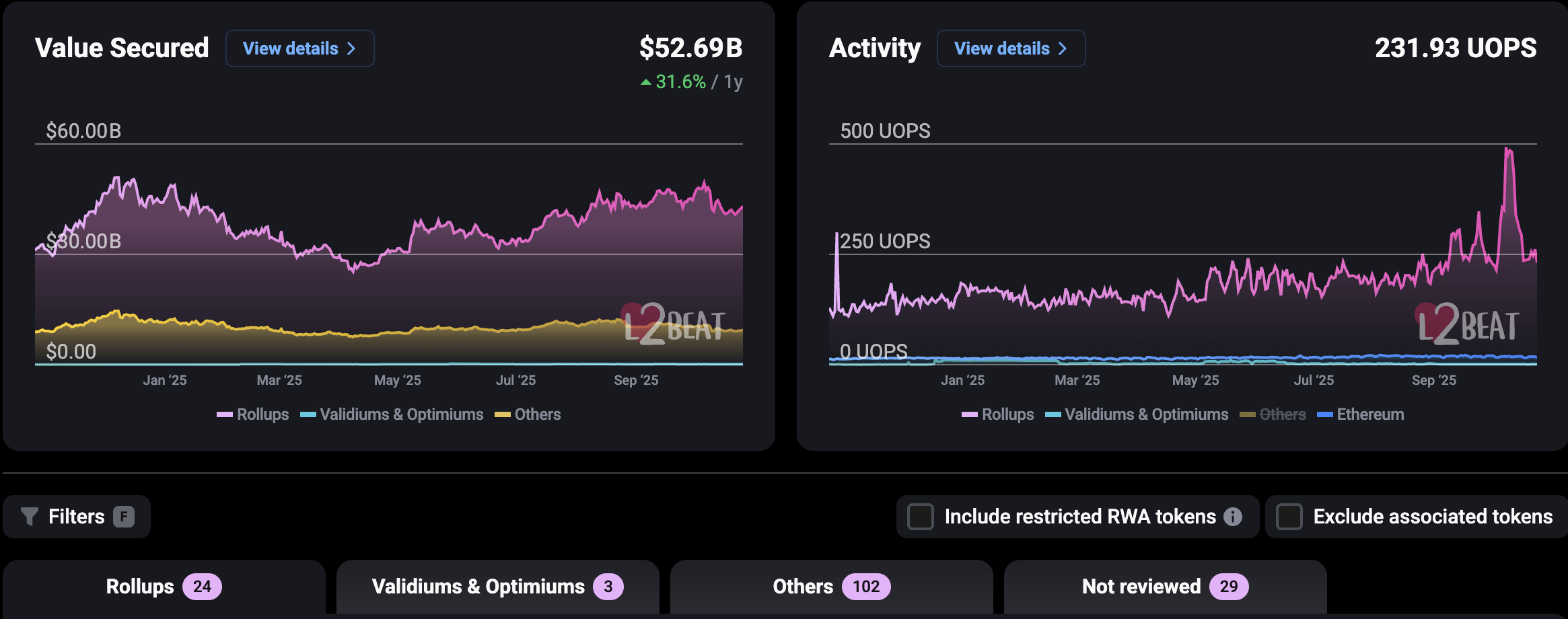Ethereum layer-2 networks face significant security and centralization risks due to large code bases, multi-signature custody vulnerabilities, and potential unauthorized fund shifts, as highlighted by Solana co-founder Anatoly Yakovenko. These issues challenge the claim that L2s fully inherit Ethereum’s base layer security.
-
Ethereum layer-2 networks expose a vast attack surface with complex code that is hard to audit thoroughly.
-
Multi-signature custody in L2s allows funds to be moved without user consent, raising centralization concerns.
-
Over 129 verified L2 networks exist, fragmenting liquidity and reducing revenue for Ethereum’s layer-1, per data from L2Beat and Binance Research.
Ethereum layer-2 security under fire: Solana’s Anatoly Yakovenko warns of risks in L2 networks. Discover debates on decentralization and proliferation. Stay informed on crypto scaling solutions today.
What Are the Security Issues with Ethereum Layer-2 Networks?
Ethereum layer-2 security is a growing concern as these scaling solutions introduce vulnerabilities not fully mitigated by the base Ethereum layer. Anatoly Yakovenko, co-founder of Solana, argues that L2 networks have expansive attack surfaces and code bases too large for comprehensive audits, potentially harboring undetected bugs. He emphasizes that the notion of L2s inheriting Ethereum’s security is flawed, especially with risks like unauthorized fund withdrawals via multi-signature setups.

Source: Anatoly Yakovenko
The debate intensified during a recent online discussion where Yakovenko stated, “The claim that layer-2s inherit ETH security is erroneous.” He further noted that after five years of L2 development, alternatives like bridging ETH to Solana via Wormhole carry comparable risks to networks like Base, yet still contribute revenue to Ethereum layer-1 stakers. This perspective underscores the ongoing tension between scalability and robust security in Ethereum’s ecosystem. Developers and users alike must weigh these trade-offs as L2 adoption surges amid Ethereum’s push for efficiency post its major upgrades.
Layer-2 solutions, designed to process transactions off the main Ethereum chain for faster and cheaper operations, rely on mechanisms like rollups and sidechains. However, this off-chain processing introduces points of failure. For instance, the reliance on multi-signature wallets for fund custody means that if a subset of signers colludes or is compromised, user assets could be at risk without direct recourse to Ethereum’s decentralized consensus. Yakovenko’s critique highlights how these setups centralize control in ways that contradict the blockchain’s core ethos of decentralization.
How Many Ethereum Layer-2 Networks Are There and Is That Too Many?
The Ethereum layer-2 landscape is expansive, with L2Beat reporting 129 verified networks as of the latest data, alongside 29 additional unverified ones. This proliferation has sparked debate on whether it fosters innovation or creates inefficiencies. Adrian Brink, co-founder of Anoma, a layer-1 protocol, contends that the industry supports about 10 times more L2s than necessary, potentially leading to redundancy and diluted focus.

An overview of the layer-2 sector. Source: L2Beat
On the other hand, Igor Mandrigin, co-founder of Gateway.fm, a Web3 infrastructure provider, views the growth positively. He argues that the explosion of L2s signals robust network expansion and ecosystem diversity, benefiting Ethereum overall. Anurag Arjun, co-founder of Avail and involved with Polygon’s L2 efforts, echoes this, stating that each L2 acts as a high-throughput blockchain, providing Ethereum users with varied, efficient options for dApps and transactions.
Despite these benefits, critics point to downsides. Binance Research analysis indicates that L2s are fragmenting liquidity across the ecosystem, as users migrate to these networks for their low fees compared to Ethereum’s layer-1. This shift is cannibalizing base layer revenue, with transaction volumes on L1 declining as L2 activity booms. For example, while Ethereum layer-1 fees once dominated, L2s now capture a significant portion of economic activity, prompting questions about long-term sustainability. Experts like those from Binance Research emphasize that this fragmentation could hinder Ethereum’s unified security model if not addressed through better interoperability standards.
The conversation extends to broader implications for Ethereum’s roadmap. As layer-2 networks evolve, initiatives like data availability sampling and shared sequencing aim to mitigate centralization risks. Yet, Yakovenko’s pointed remarks during the debate remind the community that true decentralization requires more than just scaling— it demands rigorous security protocols that don’t compromise user sovereignty. Industry executives continue to monitor these developments, with some predicting consolidation among L2s to streamline the ecosystem.
Frequently Asked Questions
What Makes Ethereum Layer-2 Networks Vulnerable to Centralization?
Ethereum layer-2 networks can centralize through multi-signature custody models where a few entities control fund access, potentially allowing unauthorized movements. Large code bases also amplify risks, as full audits become impractical, according to Solana co-founder Anatoly Yakovenko. These factors undermine the decentralized security inherited from Ethereum’s base layer.
Why Are Ethereum Layer-2 Networks Proliferating So Rapidly?
The rapid growth of Ethereum layer-2 networks stems from the need for scalable, cost-effective alternatives to the main chain’s high fees and congestion. With over 129 verified L2s per L2Beat, they offer diverse high-throughput options for users and developers. This expansion, while healthy for diversity, raises concerns about liquidity fragmentation and revenue impacts on layer-1.
Key Takeaways
- Security Risks in L2s: Vast attack surfaces and audit challenges mean Ethereum layer-2 networks don’t fully inherit base layer protections, as noted by Anatoly Yakovenko.
- Proliferation Debate: With 129+ L2s, experts like Adrian Brink argue for fewer networks, while others see growth as a sign of Ethereum’s vitality and user choice.
- Economic Impacts: L2s boost efficiency but fragment liquidity and reduce layer-1 revenue, per Binance Research—consider interoperability solutions for balanced scaling.
Conclusion
In summary, Ethereum layer-2 security and centralization concerns, amplified by voices like Solana’s Anatoly Yakovenko, highlight the trade-offs in blockchain scaling. While the abundance of over 129 L2 networks drives innovation and accessibility, it also fragments the ecosystem and challenges revenue models on the base layer. As debates rage among developers and executives, the path forward likely involves enhanced audits, better custody mechanisms, and unified standards to preserve Ethereum’s decentralized promise. Investors and users should stay vigilant, monitoring these evolutions to navigate the dynamic crypto landscape effectively.
